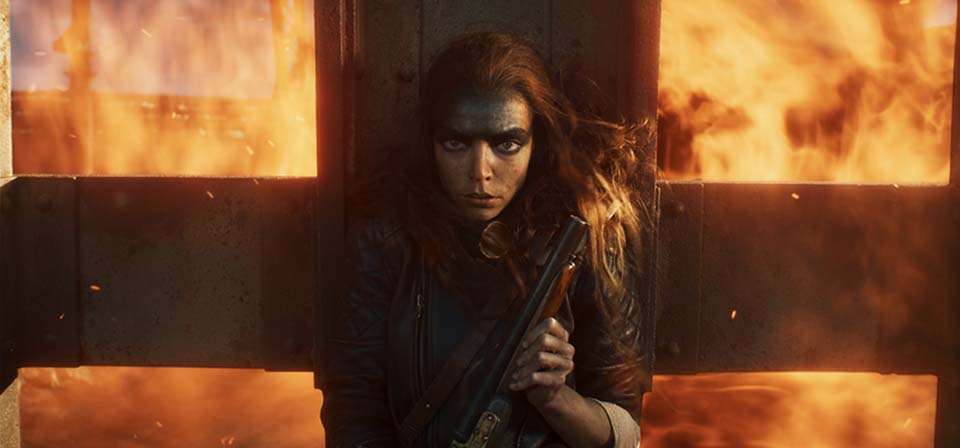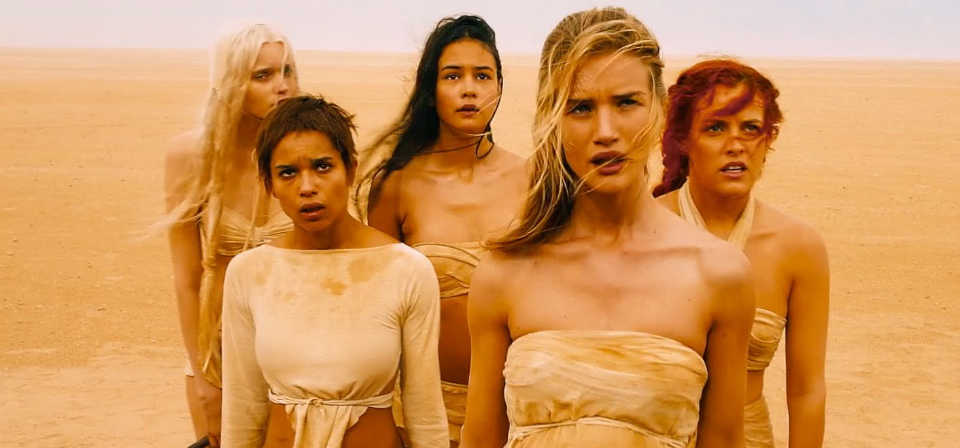Mad Max: Fury Road (2015)
In the first act of Mad Max: Fury Road, Tom Hardy’s Max spends more time than you might expect strapped helplessly to the front of a turbo-charged Chevy coupe, maniacally driven by a fanatic through a hellish landscape, an unwilling witness to the chaos ensuing around him.
Sitting in the theater, I felt about the same way, I think.
Then, as the movie continued, an improbable thing happened. Like Max, I slowly became a willing participant in the madness.
Caveat Spectator
Copious bloody violence; disturbing images and themes; brief nudity.George Miller, returning after a three-decade lacuna to the grim franchise that put a young actor named Mel Gibson on the map and helped to cement the tropes of contemporary post-apocalyptic dystopian fiction, has crafted one of the biggest, nuttiest, most overwhelming movies ever made.
Set in a nightmare world dominated by a nihilistic blood cult, Fury Road is full of nasty, grotesque imagery and horrifying incident. It is possible to wonder, in what is basically a thunderous entertainment rather than a difficult but profound art film, whether the brilliant achievements are really worth enduring the suffocatingly oppressive milieu. I wondered this myself.
And when a movie sustains this level of action mayhem, on such a scale and level of complexity, the outcome is almost always numbing. Past a certain point, pitting more and more Avengers against more and more Ultron-bots becomes a reductive experience rather than a cumulative one.
Yet, against all odds, Fury Road remains gripping to the end.
Partly it’s because of Miller’s reliance on uncompromisingly old-school practical effects and stunts over computer imagery, as well as the disciplined visual clarity with which all this action is filmed and edited, so that however crazy things get, you always know where everyone is and what’s going on.
And partly it’s because, by stripping down plot, dialogue and characterization to the bare minimum and focusing on the action, the film paradoxically heightens the significance of the action, by which the characters define themselves and which becomes the vehicle for the film’s themes. As the film unfolds, it reveals the hidden humanity of this world and of its broken title character, a shell of a man haunted by past horrors and initially reduced to the bare impulse to survive.
That last paragraph sounds so heavy that I want to recall what a gonzo work of lunacy Fury Road is. This is a movie largely made up of extended chase scenes involving characters with names like Toast the Knowing and Rictus Erectus. This is a movie in which the enemy rides into battle spurred on by a truck full of war-drumming timpani players and an immense tractor unit stacked high with an towering array of amplifiers, upon which, dangling from bungee cords, flails a flamboyantly scarlet-clad, cowled heavy-metal guitar hero called the Doof Warrior, ferociously shredding a double-neck axe like a 1980s arena-rock superstar at the height of his guitar solo — and if this isn’t already the most bizarre sentence I have ever written, let me add that the guitar, for absolutely no practical reason at all, is also a fully functioning flamethrower.
It’s also a movie about the dehumanizing, domineering power of a violent religious regime over its subjects — particularly women, but also men. The cult, led by the monstrous warlord Immortan Joe (Hugh Keays-Byrne, who played Toecutter, the main villain in the original Mad Max), talks about Valhalla, the Norse hall of the honored dead, and his warriors, called War Boys, have shaved heads and wear white stuff on their skin, giving them a skeletal or zombie-like appearance.
In other respects, though, the cult suggests an alternate-universe counterpart to the Islamic State or Boko Haram, with its blend of nihilistic violence, tyrannical social control, crushing ignorance melded with fanatical religious fervor, and especially subjugation of women as property, valued only for their fertility.
One-upping Islamic polygamy, which traditionally permits no more than four wives, Joe keeps a harem of five women in sexual slavery, chosen for their health and fertility in a world poisoned by fallout radiation. In a nightmarish early image, we see women hooked up to industrial milking machines — mother’s milk being one of the precious, life-giving fluids on which the world and the themes of Fury Road depend, along with water, blood and gasoline. (The life-giving power of blood and water, in particular, book-end the film in an important way.)
Incongruously, one of Immortan Joe’s most capable and respected commanders is a woman: Charlize Theron’s Imperator Furiosa, whose shaved head and constrained demeanor evoke the title character of Dreyer’s Passion of Joan of Arc. Furiosa isn’t the title character of Fury Road, but she turns out to be the real protagonist, joining a tiny (but perhaps growing) sorority of recent blockbuster leading ladies, along with Katniss Everdeen, Maleficent, Scarlet Johannson’s Lucy, Frozen’s Elsa and Anna, and Sandra Bullock’s mission specialist in Gravity.
While the film’s feminist implications have perhaps been overstated by some enthusiastic critics, they are striking enough. It’s a film that not only bypasses the nominal male hero to focus on an indomitable female protagonist, but which turns on female defiance of Joe’s patriarchal tyranny, condemning the characteristically male impulse to violence and destruction (“Who killed the world?” is one of two recurring motifs) and revolting against male subjugation of women (“We are not things” is the other).
The feminist vibe isn’t without caveats. The “five wives” are all played by willowy actress-models in scanty attire — presumably for the same sort of plot-level reason that Princess Leia winds up in that slave-girl metal bikini in Return of the Jedi, but the lingering slow-motion camerawork in their introductory scene evokes the same extradiegetic rationale as well; there is at least a suggestion of having your cheesecake and eating it too, or something like that. (One of the wives is great with child; highlighting the critique of their sexual slavery, the scene makes a point of cutting off heavy chastity belts with bolt cutters.) Later we meet a circle of old crones who belong to a clan of women desert bikers called the Vuvalini or Many Mothers; although they are crucial to the second half of the film, I can’t help feeling there’s a bit of an air of self-conscious feminist conceit about them.
As for Max, while he takes slow steps toward redemption, and eventually he can be said to be not just an antihero but a proper sort of hero, he never winds up either taking the reins from Furiosa or engaging her on a romantic level, turning her into a love interest. His traditional action-hero qualities are essential, but the climax of his redemption comes not in an action scene, but in an act of deeply personal self-giving. Another male character (Nicholas Hoult of the last two X-Men movies, surprisingly touching) is also offered an unexpected chance at redemption; his arc is the film’s most intriguing, and his tentative interactions with one of the female characters offers the one positive, hopeful hint at what the whole business of being male and female is all about.
For all its action and spectacle, Mad Max: Fury Road represents a sort of creative idealism that critics and cinephiles swoon for. It’s a deeply weird project, linked only to a 30-year-old franchise nobody was demanding more of. In an age of slickly corporate PG-13 popcorn movies marketed to the widest possible audience, it’s a defiantly harsh, R-rated spectacle unapologetically not for all tastes, unleavened by ironic detachment, elaborate world-building or romantic interest, let alone a love triangle.
It is, in short, a film with essentially no reason to exist, except that a septuagenarian director wanted to make it. (Miller is 70; his key collaborators include 72-year-old cinematographer John Seale and production designer Colin Gibson, whom I believe is in his 60s.) In some ways I’m still conflicted about it, but I know I want to see it again.
Related

Two things I wish George Miller had done differently in Furiosa: A Mad Max Saga
The Fury Road prequel is a satisfying return to the world of the demented 2015 film—but there were two missed opportunities, relating to Immortan Joe’s Wives and Furiosa’s revenge.

Furiosa tells the story of a world (almost) without hope
Is there no hope? This desperate question hangs over the previous film in the saga, Miller’s 2015 extravaganza Mad Max: Fury Road. Now, the same question haunts Furiosa, an epic origin-story prequel for Fury Road’s stealth protagonist, Charlize Theron’s Imperator Furiosa.

“We are not things”: Mad Max: Fury Road and commodifying human life
In another movie, a line like “We are not things” could be a platitude, but in the context of vividly imagined atrocities with unnerving echoes of recent headlines, this simple affirmation is fraught with topical power that has only grown in the months since the film’s theatrical debut.
Recent
- Benoit Blanc goes to church: Mysteries and faith in Wake Up Dead Man
- Are there too many Jesus movies?
- Antidote to the digital revolution: Carlo Acutis: Roadmap to Reality
- “Not I, But God”: Interview with Carlo Acutis: Roadmap to Reality director Tim Moriarty
- Gunn’s Superman is silly and sincere, and that’s good. It could be smarter.
Home Video
Copyright © 2000– Steven D. Greydanus. All rights reserved.